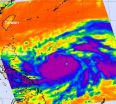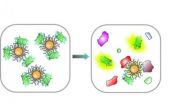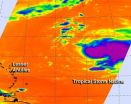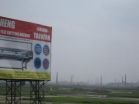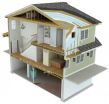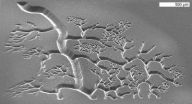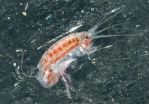(Press-News.org) Tropical Storm Sanba exploded in intensity between Sept. 12 and 13, becoming a major Category 4 Typhoon on the Saffir-Simpson Scale. NASA's Aqua satellite captured infrared data that showed a large area of powerful thunderstorms around the center of circulation, dropping heavy rain over the western North Pacific Ocean.
NASA's Aqua satellite passed over Super Typhoon Sanba on Sept. 13 at 0447 UTC (12:47 a.m. EDT). The Atmospheric Infrared Sounder (AIRS) instrument captured an infrared image of Sanba and found an eye about 20 nautical miles (23 miles/37 km) wide, surrounded by a thick area of strong convection (rising air that forms the thunderstorms that make up the storm) and strong thunderstorms. Forecasters at the Joint Typhoon Warning center noted that the AIRS imagery showed that there was "no banding outside of this ring, consistent with an annular typhoon."
On Sept. 13 at 1500 UTC (11 a.m. EDT), Sanba's maximum sustained winds were near 135 knots (155 mph/250 kmh). Sanba had higher gusts into the Category 5 typhoon category. The Saffir-Simpson scale was slightly revised earlier in 2012, so a Category 4 typhoon/hurricane has maximum sustained winds from 113 to 136 knots (130 to 156 mph /209 to 251 kmh). A Category 5 typhoon's maximum sustained winds begin at 137 knots (157 mph /252 kmh).
Sanba was located about 600 nautical miles (690 miles/1,111 km) south of Kadena Air Base, near 16.8 North latitude and 129.5 East longitude. It was moving to the north at 9 knots (10.3 mph/16.6 kmh) and generating wave heights of 40 feet.
Sanba is expected to continue on a north-northwesterly track through the western North Pacific and move through the East China Sea, passing close to Kadena Air Base, Okinawa, Japan on Sept. 15.
INFORMATION:
NASA sees Sanba become a super typhoon
2012-09-14
ELSE PRESS RELEASES FROM THIS DATE:
UMass Amherst chemists develop nose-like sensor array to 'smell' cancer diagnoses
2012-09-14
AMHERST, Mass. – In the fight against cancer, knowing the enemy's exact identity is crucial for diagnosis and treatment, especially in metastatic cancers, those that spread between organs and tissues. Now chemists led by Vincent Rotello at the University of Massachusetts Amherst have developed a rapid, sensitive way to detect microscopic levels of many different metastatic cell types in living tissue. Findings appear in the current issue of the journal ACS Nano.
In a pre-clinical non-small-cell lung cancer metastasis model in mice developed by Frank Jirik and colleagues ...
'Smart growth' strategies curb car use, greenhouse gas emissions, SF State study suggests
2012-09-14
A new study finds that smart growth approaches to urban planning could substantially reduce the number of miles that residents drive in a year. The research was published this week in The B.E. Journal of Economic Analysis and Policy.
Smart growth focuses on the development of compact, walkable cities with houses and jobs located close together. By shortening residents' commutes, this form of urban design aims to cut transportation-related energy use and greenhouse gas emissions. California is already pursuing smart growth in order to meet emissions reductions set by the ...
NASA sees wind shear battering Tropical Storm Nadine
2012-09-14
Tropical Storm Nadine is struggling against wind shear and some dry air. Infrared satellite imagery from NASA showed that Nadine's most powerful thunderstorms were being pushed east of the center.
NASA's Aqua satellite passed over Tropical Storm Nadine early on Sept. 13 and saw several factors that indicated the storm was still struggling to achieve hurricane status.
Infrared data from the Atmospheric Infrared Sounder (AIRS) that flies aboard Aqua found the strongest thunderstorms with very cold cloud temperatures (colder than -63F/-52C) were being pushed east of Nadine's ...
Warmer temperatures make new USDA plant zone map obsolete
2012-09-14
Gardeners and landscapers may want to rethink their fall tree plantings. Warming temperatures have already made the U.S. Department of Agriculture's new cold-weather planting guidelines obsolete, according to Dr. Nir Krakauer, assistant professor of civil engineering in The City College of New York's Grove School of Engineering.
Professor Krakauer developed a new method to map cold-weather zones in the United States that takes rapidly rising temperatures into account. Analyzing recent weather data, he overhauled the Department of Agriculture's latest plant zone map released ...
Researchers develop rapid method to measure carbon footprints
2012-09-14
Researchers have developed new software that can rapidly calculate the carbon footprints of thousands of products simultaneously, a process that up to now has been time consuming and expensive. The methodology should help companies to accurately label products, and to design ways to reduce their environmental impacts, said Christoph Meinrenken, the project's leader and associate research scientist at Columbia University's Earth Institute and Columbia Engineering. A new study, published online in the Journal of Industrial Ecology, describes the methodology.
The project ...
Home sweet lab: Computerized house to generate as much energy as it uses
2012-09-14
In a ribbon-cutting ceremony on Sept. 12, 2012, the U.S. Commerce Department's National Institute of Standards and Technology (NIST) unveiled a new laboratory designed to demonstrate that a typical-looking suburban home for a family of four can generate as much energy as it uses in a year. Following an initial year-long experiment, the facility will be used to improve test methods for energy-efficient technologies and develop cost-effective design standards for energy-efficient homes that could reduce overall energy consumption and harmful pollution, and save families money ...
Nanoengineers can print 3D microstructures in mere seconds
2012-09-14
Nanoengineers at the University of California, San Diego have developed a novel technology that can fabricate, in mere seconds, microscale three dimensional (3D) structures out of soft, biocompatible hydrogels. Near term, the technology could lead to better systems for growing and studying cells, including stem cells, in the laboratory. Long-term, the goal is to be able to print biological tissues for regenerative medicine. For example, in the future, doctors may repair the damage caused by heart attack by replacing it with tissue that rolled off of a printer.
Reported ...
Childrem of immigrants come out ahead of peers
2012-09-14
Children of immigrants are outperforming children whose family trees have deeper roots in the United States, learning more in school and then making smoother transitions into adulthood, according to sociologists at The Johns Hopkins University.
Researchers Lingxin Hao and Han S. Woo tracked nearly 11,000 children from as young as age 13 into their early 30s, coming from families with diverse backgrounds. When comparing children with similar socioeconomic status and school conditions, Hao and Woo found that the best students, and later the most successful young adults, ...
Surviving without ice
2012-09-14
With sea ice in the Arctic melting to record lows in summer months, marine animals living there face dramatic changes to their environment. Yet some crustaceans, previously thought to spend their entire lives on the underside of sea ice, were recently discovered to migrate deep underwater and follow ocean currents back to colder areas when ice disappears.
"Our findings provide a basic new understanding of the adaptations and biology of the ice-associated organisms within the Arctic Ocean," said Mark Moline, director of the University of Delaware's School of Marine Science ...
Should I marry him?
2012-09-14
Doubt is not a pleasant mental state, but certainty is a ridiculous one.
—Voltaire
In the first scientific study to test whether doubts about getting married are more likely to lead to an unhappy marriage and divorce, UCLA psychologists report that when women have doubts before their wedding, their misgivings are often a warning sign of trouble if they go ahead with the marriage.
The UCLA study demonstrates that pre-wedding uncertainty, especially among women, predicts higher divorce rates and less marital satisfaction years later.
"People think everybody has ...
